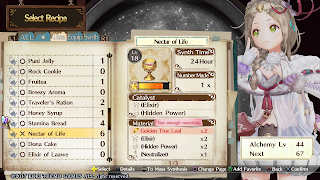An alchemist in-training, Firis, has one year to travel to Reisenburg and take the alchemy exam to become a certified alchemist. If she fails to pass the test, Firis will be forced to return to her home in the underground.
The gameplay is split between gathering ingredients, fighting monsters out in the field, and socializing or synthesizing new items at the Atelier (Firis's home). The game introduces a sprawling open world and Firis will need to continuously craft better tools, health items, armor, and weapons to get the most out of it. New skills and recipes are gradually unlocked from experimenting with different items or gathering materials. Alternatively, the player can purchase some recipes with "Idea Points" earned from completing quests. Time management also plays a small role. For the most part, you're allowed to do what you want when you want, until the year deadline is up. The deadline prevented me from staying in one area for too long, and eliminated the stagnation I felt in Sophie by keeping everything moving along at a steady pace. I never felt rushed, even with the new LP system that limits how much you can do in a day, and forces Firis to go back to her atelier to sleep.
The world map is comprised of massive, inter-connected areas. Each location contains some points of interest - settlements, landmarks, or the odd cave. Some monsters (a resource) will only appear during specific times of the day or during certain weather conditions like sandstorms. Much like the enemies, collectable materials in the environment will also change depending on the time of day and weather.
The atelier is mobile, acting like a camp.
Alchemy is the bread and butter of the Atelier series. Firis uses a simple grid-like puzzle system of synthesizing new items. Recipes require items from up to four categories, and 1 to 5 items (depending on the difficulty) from each category. Every item has a size, a number, and a color. The size determines the number of blocks and shape that the material will occupy on the grid. The quality of the synthesized item is determined by the quality of the material used and how much of the grid was covered (more is better). If you use one of the new "catalysts", the entire panel could grow or the effects from covering lines can change.
Left: Selecting a recipe. Right: Choosing the ingredients.
During synthesis, there will be up to three "effects" listed in different colored boxes to the right-hand side. Sandwiched between the "Effects" boxes and the quality, size, and count boxes, is a component gauge. Every material placed down will add to the gauge. When the component gauge levels up, every Effect fills up by half an icon (white dot). Effects that share the same color as the material that caused the level up will fill up by an icon and a half.
At the top of the grid are five colored bars - red, blue, green, yellow, and purple. The percentage number above these bars adds a boost to the "effect" of the same color. Placing any material down will add to the percentage bar of the same color. Covering lines on the grid will grant additional instant bonuses. Placing materials on lines of a matching color will increase the percentage bar of the same color. How much of the grid you manage to cover, and with what colors, will also affect the percentage bars at the top of the grid. Materials can be placed on top of one another, but doing so will remove the boost gained from the material that were 'pushed down' (you still retain the initial placement boost).
At specific points in the story you will be tasked with creating very difficult, large scale items that require a ton of components. The synthesized item will also have to be of a certain quality to to maintain its constitution. It’s an interesting concept that challenges your alchemy skills as you go. A new feature to the Mysterious series is the ability to customize the inside of your workshop. Some of the items you create or purchase from a merchant can be placed inside the atelier to gain special effects that will help support Firis' talents.
The battle system is pretty intuitive, if not a little basic. Characters can be equipped with defensive, offensive, and consumable items that Firis makes in her atelier. At the start of your turn you get to attack with each of your party members in succession, unlike in the previous game. A yellow Chain Burst Gauge fills up with each successful attack and can be depleted by performing follow up attacks or guarding another party member. A Chain Burst is activated automatically when the gauge is maxed out. This allows the party to perform follow-up moves on an enemy that increase in power depending on the number of allies who are participating. There are also "Chain Strikes", special abilities unique to each character that are activated by performing a chain attack with 3 or more allies, or having 130% linkage by the end of it. The last person in the chain will activate their Chain Strike.
To date Firis is my favorite Atelier game. The open-world suits this type of game well, and the time limit gave the game a sense of urgency that prevented the lull I get from other games in the series. The large projects at regular intervals - ones that directly tied into Firis's journey, were a welcome change to the usual quest-board type missions in the series.
Related Reviews:





















No comments:
Post a Comment